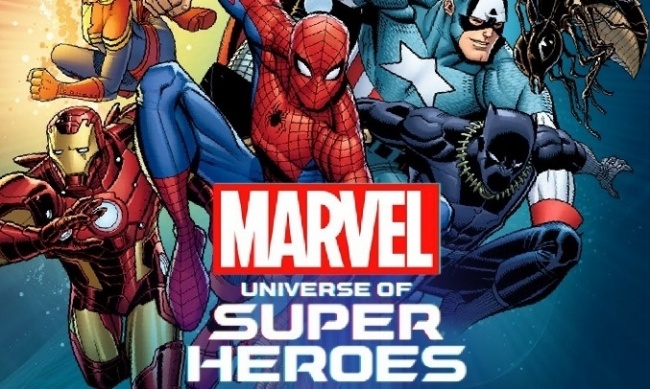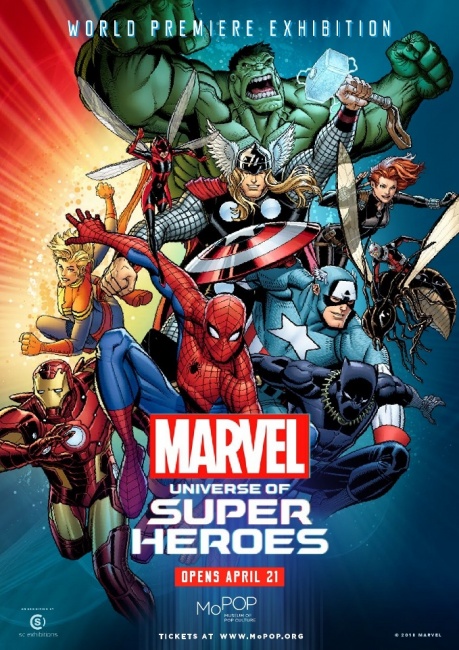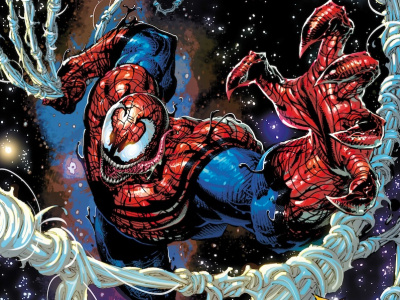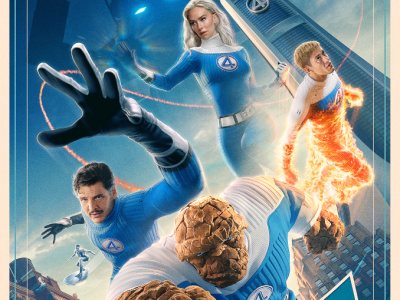Any fan of comics and comics art understands that the medium’s best work belongs in a museum, alongside creative masterpieces of painting, sculpture and the other arts. But even though exhibitions of comic art are becoming more common in museums and galleries in North America, mounting these sorts of shows poses a lot of business and logistical problems. Not least is how you make the black and white original artwork, usually done on 11"x17" art boards, as exciting to viewers as the full-color, larger-than-life mental images of superheroes from comics, movies and videogames.
Curators have made some strides in this area in the past few years. However, the new ”Marvel: Universe of Super Heroes” show opening this weekend at the Museum of Pop Culture (MoPOP) in Seattle sets a new standard in scope, ambition and total experience.
80 Years of Marvel on Display. The exhibit collects over 300 artifacts from the 80-year history of Marvel, starting with the only surviving original art from Marvel Comics #1 (a page from the Bill Everett Sub-Mariner story) and extending to props, costumes and production art from the Marvel Cinematic Universe, right up to Avengers: Infinity War. It is the largest exhibit ever put on by MoPOP, taking up two floors of the sprawling museum in the shadow of the Space Needle, and is designed to appeal to everyone from the neophyte to the hardest-core fan.
Chief curator Benjamin Saunders, a comics scholar at University of Oregon, and his team (scholars Matthew Smith and Randy Duncan, comic industry pros Ann Nocenti and Danny Fingeroth, MoPOP curators Brooks Peck and Jacob McMurray, produced by SC Exhibitions) have devised a brilliant exhibit plan that capitalizes on the mass-media notoriety of Marvel’s pantheon to focus attention on the creators and the original comic storylines, which most moviegoers may not know.
The exhibit starts at a facsimile of a newsstand, the traditional point of entry for fans of a certain age and the vehicle through which comics became a popular art form in the US in the first place. The Golden Age room includes infographics tracing the development of comic books from newspaper strips and pulps, and displays a few treasures including the Sub-Mariner page and a prime copy of Marvel Comics #1. From there, it’s off to the Silver Age, with rooms devoted to the heavy hitters, from Spider-Man to Thor, Doctor Strange and the X-Men.
A Feast for Art Fans. Every room contains at least one jaw-dropping "grail" piece: an original page from Amazing Fantasy #15 featuring Steve Ditko’s first drawing of Spider-Man in costume, on loan from the Library of Congress; Steranko’s original Nick Fury #1 cover; Frank Miller’s iconic three page sequence showing the death of Elektra from Daredevil #181; Dave Cockrum’s original art to the cover of Giant-Size X-Men #1, alongside a stunning Bill Sienkiewicz multimedia New Mutants cover. Look carefully and you’ll see John Romita Sr.’s original character design drawing of the Punisher and other treasures. This show goes deep.
All this priceless original art is shown alongside full color graphics of stories and characters, as well as the original costumes and props from most of the major MCU films. There’s even a room and a half devoted to the Guardians of the Galaxy and other cosmic heroes, featuring a wall-sized infographic tracing the confusing lineage of Captain Marvel and, on a facing wall, an inventory of Marvel’s main alien races and characters, assessed by threat level.
The exhibit uses some state of the art technology to engage audiences. Visitors can stand on a special platform and see themselves transformed into Iron Man’s armor using the same effects from the movie, via augmented reality. Various workstations present and explain the production of comics art, from drawing to lettering to coloring and reproduction. The most visually striking part of the show is the Doctor Strange room, where Steve Ditko’s psychedelic art is blown up and bounced off mirrors to recreate the experience of being inside the dread Dormammu’s dimension of doom.
A Heroic Undertaking. This was all clearly the result of the collaboration between an institution with deep pockets (MoPOP was founded by Microsoft co-founder and major geek Paul Allen) and a crew of very clued-in nerd scholars on a mission. The show needed the talents and resources of both groups to pull off a show on this scale, in part because of the logistics.
"Few if any institutions collected comic art in the 20th century," said Saunders. "That means almost every major piece is in the hands of individual collectors."
The Marvel show draws heavily from two prominent art collections in addition to the materials on loan from Marvel Studios and other sources. Several times during the press tour, Saunders noted the insurance costs associated with displaying such high-value, one-of-a-kind collectibles.
Whatever the expenses and complexities associated with mounting the show, the aesthetic payoff is worth it. This is the museum show that comic fans deserve – one curated with deep knowledge of the material and reverential respect for the creators, while extending every bridge to the mass audience.
It runs through January 4, 2019 in Seattle, then will head on tour, according to the organizers.
Click the Gallery below for pics of some of the artifacts in this exhibit!

Column by Rob Salkowitz
Posted by Rob Salkowitz on April 18, 2018 @ 7:38 pm CT
MORE COMICS
'Venom' #252 to Feature Backup Story with New Suit, Plus New Story by DeFalco and Frenz
August 4, 2025
Venom #252 will feature a backup story about Venom’s new suit as well as a backup story by Tom DeFalco and Ron Frenz, the creators of the symbiote suit.
Showbiz Round-Up
August 4, 2025
The post-SDCC showbiz news is still spicy a week after the show's conclusion. It's time for another round-up!
MORE COLUMNS
Column by Scott Thorne
August 4, 2025
This week, Scott Thorne addresses some comments on last week's column and the right price for starter products.
Column by Scott Thorne
July 28, 2025
This week, columnist Scott Thorne comments on the Edge of Eternities prerelease and on Magic: The Gathering news from the Hasbro earnings report.





 View Gallery: 13 Images
View Gallery: 13 Images 



